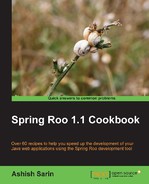In the Creating a Roo project recipe, you saw that when you create a new project, a log4j.properties file is automatically created with default logging configuration. In most real projects, you'd like to customize the default logging configuration. By default, the log4j.properties file configures root logger at ERROR level and logging is not enabled for the project.
In this recipe, we will look at the logging setup command to modify the logging configuration.
Start the Roo shell from the C:
oo-cookbookch01-recipe directory, which contains the flight-app Roo project.
Using the logging setup command you can specify the logging level and the package to which it applies, as shown in the following steps:
- The following
loggingsetupcommands are used to change the logging level of rootLogger toDEBUG(which isERRORby default) and enableDEBUGlevel logging for all classes in theflight-appapplication:roo> logging setup --level DEBUG --package ROOT Updated SRC_MAIN_RESOURCESlog4j.properties roo> logging setup --level DEBUG --package PROJECT Updated SRC_MAIN_RESOURCESlog4j.properties
As the output from the command execution suggests, some changes have been made by Roo to the
log4j.propertiesfile. - To confirm that the changes have been made to the
log4j.properties, you can either view it directly by opening the file or you can use thepropertieslistcommand (explained in the next recipe).
The logging setup command is processed by the Logging add-on of Spring Roo. The following table describes the arguments that the logging setup command accepts:
|
Argument |
Purpose |
|---|---|
|
This is a mandatory argument, which identifies the logging level. It can only take one of the pre-defined values, like | |
|
This is an optional argument, which specifies the package to which the logging level applies. It can only take one of the pre-defined values, such as |
As of Spring Roo 1.1.3, using the logging setup command you can't specify a custom package name as the value of the package argument; therefore, you can set a custom package name either by using the properties set command (explained later in this chapter) or by directly editing the log4j.properties file.
